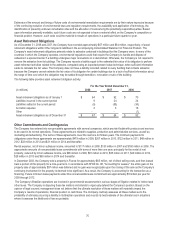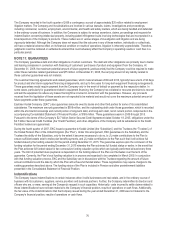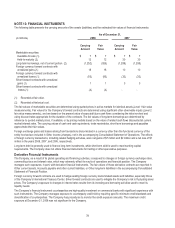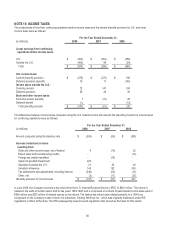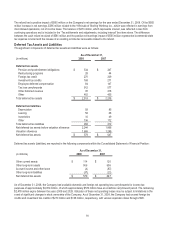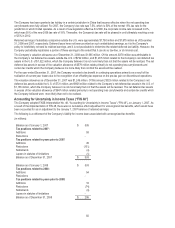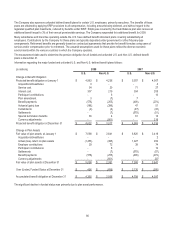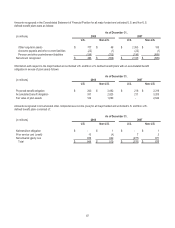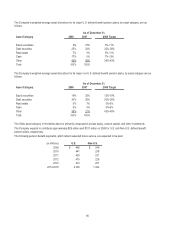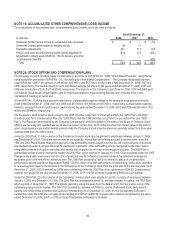Kodak 2008 Annual Report Download - page 87
Download and view the complete annual report
Please find page 87 of the 2008 Kodak annual report below. You can navigate through the pages in the report by either clicking on the pages listed below, or by using the keyword search tool below to find specific information within the annual report.85
2008 Activity
The Company recognizes the need to continually rationalize its workforce and streamline its operations to remain competitive in the
face of an ever-changing business and economic climate. For 2008, these initiatives were referred to as ongoing rationalization
activities.
The Company recorded $149 million of charges, net of reversals, including $6 million of charges for accelerated depreciation and $3
million of charges for inventory write-downs, which were reported in Cost of goods sold in the accompanying Consolidated
Statement of Operations for the year ended December 31, 2008. The remaining costs incurred, net of reversals, of $140 million were
reported as Restructuring costs, rationalization and other in the accompanying Consolidated Statement of Operations for the year
ended December 31, 2008. The severance and exit costs reserves require the outlay of cash, while long-lived asset impairments,
accelerated depreciation and inventory write-downs represent non-cash items.
The severance costs related to the elimination of approximately 2,350 positions, including approximately 375 photofinishing, 1,050
manufacturing, 175 research and development, and 750 administrative positions. The geographic composition of the positions
eliminated includes approximately 1,450 in the United States and Canada, and 900 throughout the rest of the world.
The charges, net of reversals, of $149 million recorded in 2008 included $36 million applicable to the FPEG segment, $42 million
applicable to the CDG segment, $49 million applicable to the GCG segment, and $22 million that was applicable to manufacturing,
research and development, and administrative functions, which are shared across all segments.
As a result of these initiatives, severance payments will be paid during periods through 2009 since, in many instances, the
employees whose positions were eliminated can elect or are required to receive their payments over an extended period of time. In
addition, certain exit costs, such as long-term lease payments, will be paid over periods throughout 2009 and beyond.
2009 Program
On December 17, 2008, the Company committed to a plan to implement a targeted cost reduction program (the 2009 Program) to
more appropriately size the organization as a result of the current economic environment. The program involves rationalizing selling,
administrative, research and development, supply chain and other business resources in certain areas and consolidating certain
facilities.
In connection with the 2009 Program, the Company expects to incur total restructuring charges in the range of $250 million to $300
million, including $225 million to $265 million of cash related charges for termination benefits and other exit costs, and $25 million to
$35 million of non-cash related accelerated depreciation and asset write-offs. The 2009 Program will require expenditures from
corporate cash in the range of $125 million to $175 million, as most of the termination benefits for U.S. employees will be provided in
the form of special retirement benefits (Special Termination Program (STP) benefits) payable from the Company’s over-funded U.S.
pension plan. The majority of the actions contemplated by the 2009 Program will be completed in the first half of 2009, with all
actions under the program expected to be completed by the end of 2009. The 2009 Program is expected to result in employment
reductions in the range of 2,000 to 3,000 positions when complete. When combined with rationalization actions taken in late 2008,
the Company expects to reduce its worldwide employment by between 3,500 and 4,500 positions during 2009, approximately 14% to
18% of its total workforce.
NOTE 17: RETIREMENT PLANS
Substantially all U.S. employees are covered by a noncontributory defined benefit plan, the Kodak Retirement Income Plan (“KRIP”),
which is funded by Company contributions to an irrevocable trust fund. The funding policy for KRIP is to contribute amounts sufficient
to meet minimum funding requirements as determined by employee benefit and tax laws plus any additional amounts the Company
determines to be appropriate. Generally, benefits are based on a formula recognizing length of service and final average earnings.
Assets in the trust fund are held for the sole benefit of participating employees and retirees. They are comprised of corporate equity
and debt securities, U.S. government securities, partnership investments, interests in pooled funds, real estate, and various types of
interest rate, foreign currency and equity market financial instruments.
In March 1999, the Company amended the KRIP to include a separate cash balance formula for all U.S. employees hired after
February 1999. All U.S. employees hired prior to that date were granted the option to choose the traditional KRIP plan or the Cash
Balance plan. Written elections were made by employees in 1999, and were effective January 1, 2000. The Cash Balance plan
credits employees' accounts with an amount equal to 4% of their pay, plus interest based on the 30-year treasury bond rate. In
addition, for employees participating in the Cash Balance plan and the Company's defined contribution plan, the Savings and
Investment Plan (“SIP”), the Company matched dollar-for-dollar on the first 1% contributed to SIP and $.50 for each dollar on the
next 4% contributed. Company contributions to SIP were $13 million, $14 million, and $15 million for 2008, 2007, and 2006,
respectively. The Company suspended its matching contribution for 2009.


